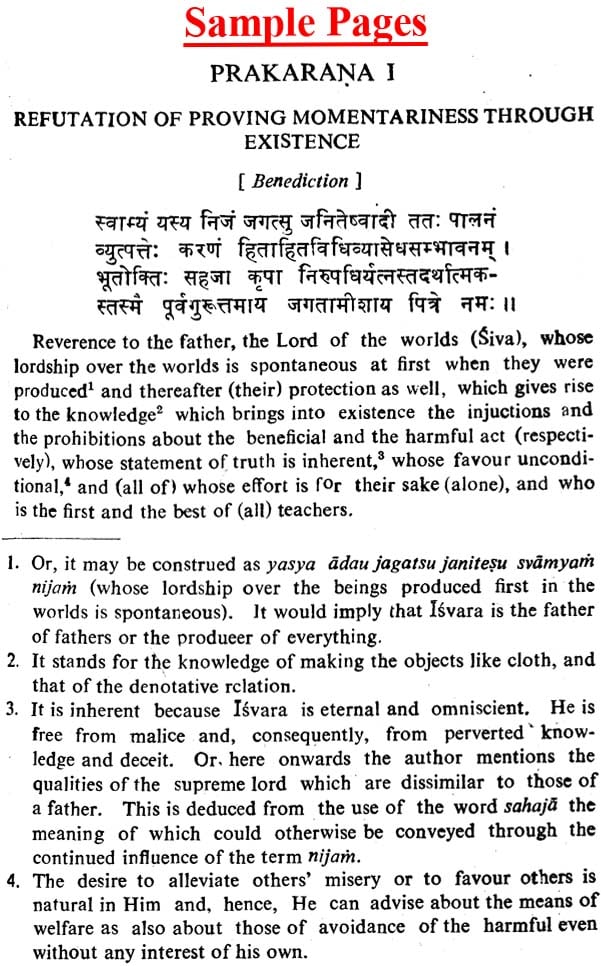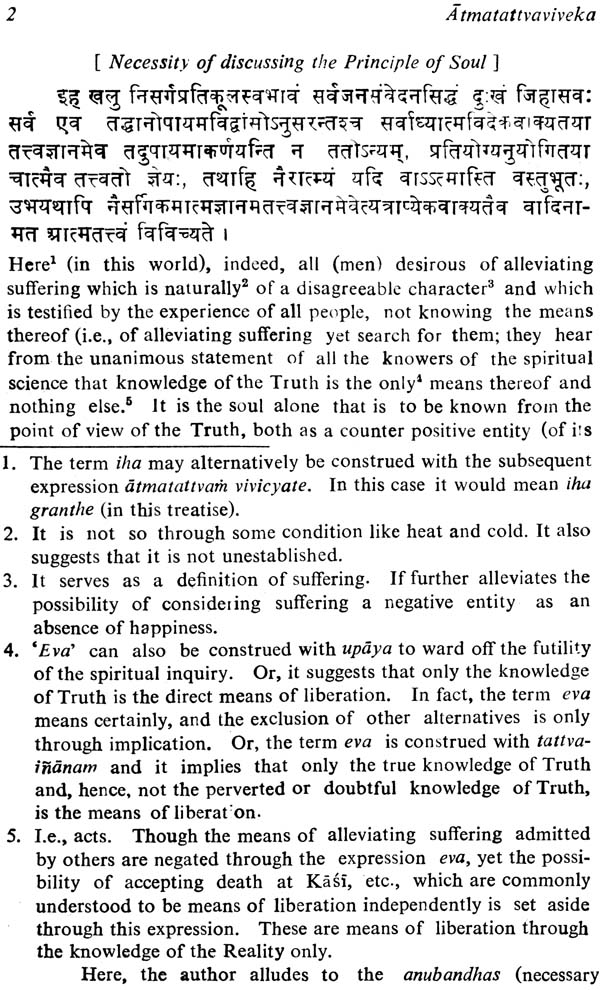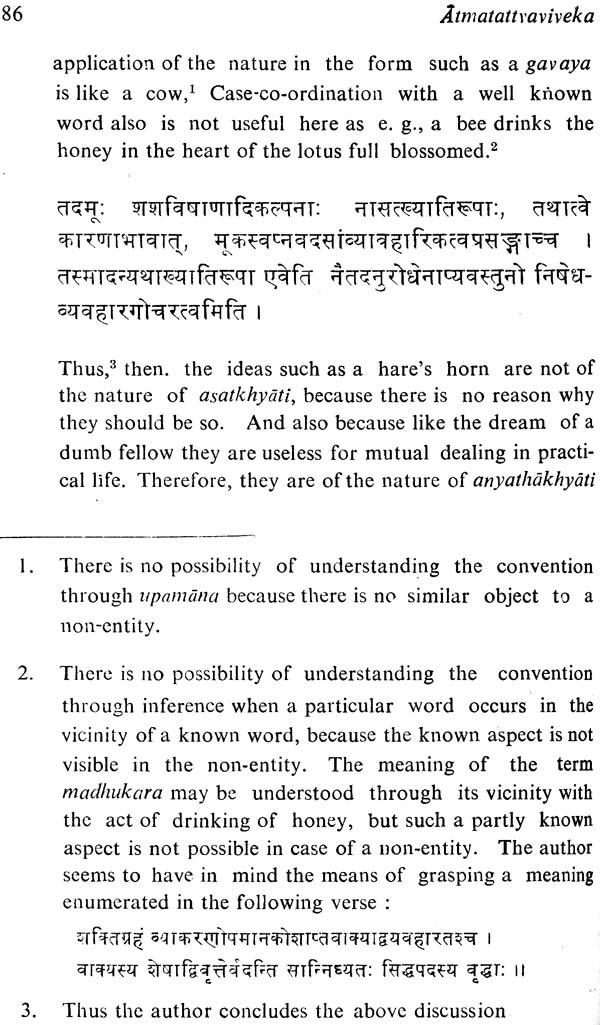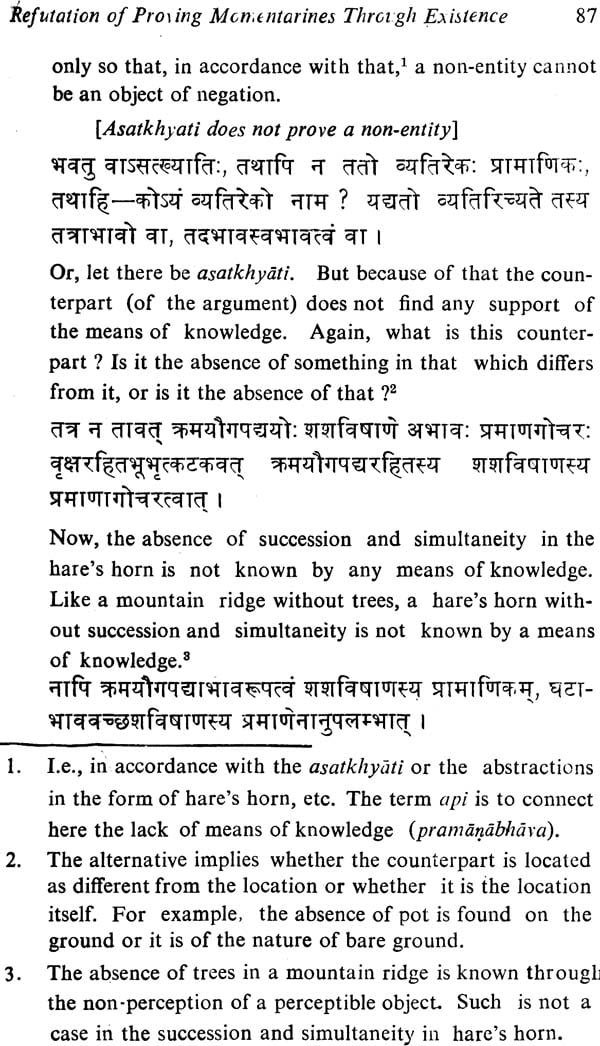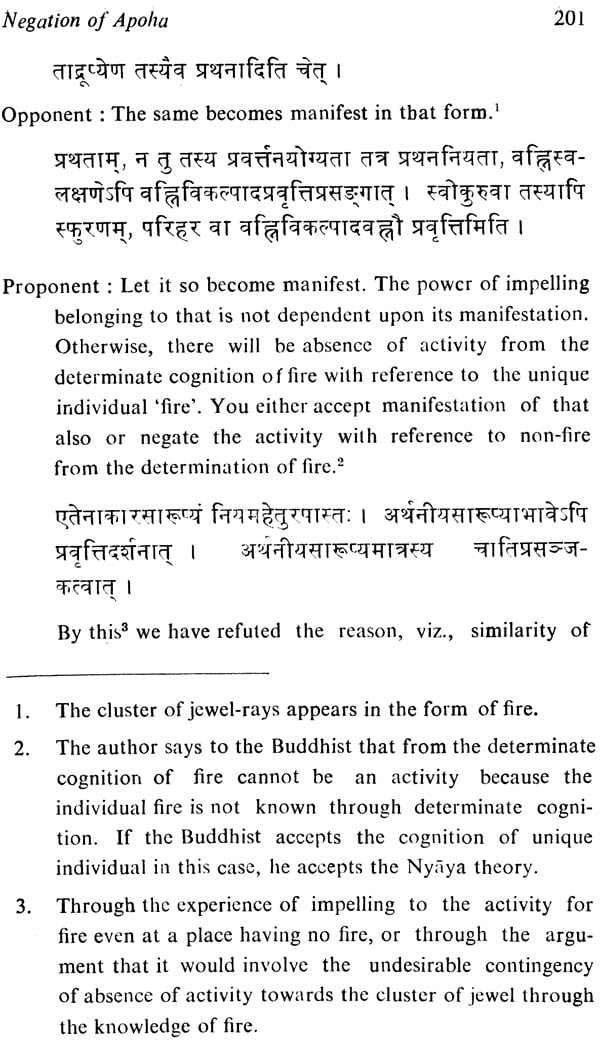
Atmatattva Viveka of Udayana (An Old and Rare Book)
Book Specification
| Item Code: | NAP390 |
| Author: | Dr. Chitrarekha V. Kher and Dr. Shiv Kumar |
| Publisher: | Eastern Book Linkers |
| Language: | English |
| Edition: | 1987 |
| Pages: | 260 |
| Cover: | Hardcover |
| Other Details | 8.5 inch X 5.5 inch |
| Weight | 390 gm |
Book Description
Udayana, the author of Atmatattva-viveka was a Maithila brahmana by birth and flourished in the second half of the tenth century. Besides his celebrated work Atmatattvaviveka, he wrote Laksanamala. Nyayakusumarijali, Nyayaparisuddhi and Kiranavali on Praiastapada's Padarthardha rmasamgraha.
The Subject discussed in Atmatativa-viveka is the acceptance or the rejection of the soul that constitutes a prominent demarcating line between the two sects of philosophical systems—brahmanical and the Buddhist. Udyana took a comprehensive note of Buddhist philosophy and is considered to be the last word in the controversy between Buddhism and Nyaya.
The Atmatattvaviveka, therefore represents a landmark in the controversy between the Buddhists and the Naiyayikas.
The present work was undertaken by (late) Dr. (Miss) Chitrarekha V. Kher in course of her studies for Ph. D. on Buddhism as presented by Brahmanical systems. The through understanding of the Atmatattvaviveka requires a profound Knowledge of Buddhism and the brahmanical systems specially the Nyaya. No one was better fitted for such a work than Dr. Chitrarekha kher However, the premature death carried her off at a time when she was most needed. Naturally, the work suffered a great setback. She left behind her ample material on translation which required a final revision. I tried my best to find out a scholar fit for the present work, but my efforts could not bear any fruit, and the work could not be brought out of its frozen state. The urgency of the work and the friendly insistence from all sides prompted me to undertake it to its completion with the addition of the explanatory notes. Though a great task, it was a sacred obligation that I owe to my teacher]. I must evince gratitude to Dr. S.M. Shaha who encouraged me during the present venture. I am also thankful to Sh. Sham Lal, Prop. Eastern Book Linkers, Delhi who willingly undertook the publication of the work. It prepares a firm ground for me to continue the rest of the portion on the same lines.
Indian philosophy basically aims at the removal of misery. Such a thirst resulted into the search for the causes of misery and the means for removing it. The limitations of the worldly means open the direction for the attempts at a logical explanation of the problem of the Reality and a reasoned expression of the spiritual experience. Such attempts were basically prompted by two lines of approach, viz., the acceptance and the rejection of the Vedas as the authority in the worldly as well as the spiritual matters. The followers of the earlier approach were termed astika (orthodox) and the others, the nastika (heterodox). Naturally the nastika systems signify an antagonistic attitude in a high degree to the vedic literature and developed a negative attitude to those matters which were of crucial importance in the astika systems and formed the main plank of the ethical, religious and philosophical teachings of the astika systems. Thus, the nastika systems stood against the essential factors of brahmanic culture like sacrificial and ritualistic practices, the distinction among men based on four social classes and a positive outlook towards life. [Thus was marked a line of demarcation between the astika systems like Nyaya, Vaisesika, Samkhya, Yoga, Purvamimamsa and the Uttaramimamsa on the one hand and the nastika systems like Buddhism, Jainism and carvaka on the other]. The Buddhism sponsored a monk-ideal as the symbol of good life. In the philosophical sphere, the Buddhists deny the soul as supported by the theory of universal flux which resulted into the denial of any enduring thing, the substance, a whole of an act, real relation, causation as a real process, time, etc.
The Atmatattraviveka represents a landmark in the controversy between the Buddhists and the Naiyayik as. The Nyaya system has waged a fierce and continuous intellectual warfare with the Buddhists from the very beginning. Gautama and Vatsyayana criticise many doctrines of the Sarvastivadins (specially the Sautrantikas), the Vijnanavildins and the Silnyavadins. Dinnaga from the Buddhist side threw many blemishes to the Nyaya system and was criticised by Uddyotakara who was in turn severely criticised by Dharmakirti as also Santara-ksita and Kamalasila. Vacaspati Misra and Jayantabhatta carried out the task of defending the Nyaya system against the onslaught of the Buddhist logicians. Vacaspati Mira and Trilocana were severely criticised by jnanasrimitra and Ratnakirti. Udayana took a comprehensive note of Buddhist philosophy and is considered to be the last word in the controversy between Buddhism and Nyaya.
Udayana was a Maithila brahmana by birth and flourished in the second half of the tenth century. Besides his celebrated work Atmatattvaviveka, he wrote Laksanamala, Nyayakusumanjali, Nyayaparisista, Nyeyaparisuddhi and Kiranavali on Prasastapada's Padarthadharmasamgraha.
The subject discussed in the Atmatattraviveka is of crucial importance in Indian Philosophy. The acceptance or the rejection of the soul constitutes a prominent demarcating line between the two sects of philosophical systems —brahmanical and the Buddhist. Udayana has, therefore, discussed the most important issue in Atmatattvaviveka. It would be worthwhile to review briefly the above controversy in Indian Philosophy. The issue of the existence and the nature of soul has been a subject of deep probing in the systems of Indian philosophy. The Naiyayikas assert that the souls are permanent entities as the substantives of the qualities of desire, pleasure, pain, etc. The Vaisesikas subscribe to the same with the addition that it can be directly perceived. The Samkhya and Yoga hold that there are many permanent souls which are conscious but inactive. The Parvamimarhsakas also believe in souls to be numberless permanent conscious entities. The different schools of Uttaramimamsa unanimously accept the existence of soul with their internal differences regarding the details. The Jainas opine that there are many permanent and conscious souls having the dimensions of the respective bodies. The carvakas believe that the body is all-in-all and do not worry about any-thing like soul.
The doctrine of the permanent soul is an anathema for the Buddhists. They hold that the soul generally understood by the notion of 'I' is merely a bundle of five different elements called skandhas. There is no soul apart from the vijnanaskandha. Vedana (feeling), samjna (idea), cetana (volition), manas (mind) and samskaras (impressions) are the forms of vijnana only. Vinana has the capacity to know and to enjoy. The soul comes to be a conceptual construction. The Buddhists find no reality of soul on the ground that the functions attributed to the soul can well be performed by the continuum of momentary consciousness. Moreover, the facts of agency and enjoyment signifying change and movement are incompatible with an eternal and all-pervasive character of the soul. If the change of state is denied, there can be no real agency and experience and as a result the soul comes to be as good as a non-entity.
Contents
| Preface | ix |
| Introduction | xi |
| PRAKARNA I | |
| Refutation of Proving Momentariness through Existence | 1-97 |
| Benediction | 1 |
| Necessity of discussing the principle of Soul | 2 |
| Sublating factors of the existence of sou | 4 |
| Refutation of the theory of Momentariness | 4 |
| Refutation of Invariable association of existence with Momentariness | 5 |
| Rejection of Difference through opposite attributes | 5 |
| Causal efficiency cannot be active agency | 7 |
| Causal efficiency cannot be Competency | 9 |
| One's own peculiar competency is not different from seedness | 10 |
| Nature of 'not bearing any delay' in case of a cause rejected | 12 |
| Refutation of causal effieiency as that expressed so | 15 |
| Refutation of Kurvadrapatva as a special class-character | 25 |
| Seed-character is a cause of Sprout | 32 |
| Refutation of opposition in character due to difference of Time | 44 |
| Refutation of Positive and Negative Determinants of Difference | 46 |
| Refutation of difference in efficiency due to difference of Place | 52 |
| difference of Place Refutation of ever productivity of the Productive | 56 |
| Refutation of opposition characterised by association or dissociation of assisting conditions | 58 |
| Refutation of opposition involved in contact | 60 |
| Refutation of counter example of association of existence with momentariness | 62 |
| Alleviation of self-contradiction in negation of a non-entity | 63 |
| Asatkhyati does not prove a non-entity | 87 |
| Imaginary conditions are not sufficient for Inference | 92 |
| PRAKARNA II | |
| Character of meeting Destruction naturally cannot prove Momentariness | 98-128 |
| Refutation of causelessness of Destruction | 98 |
| Refutation of Identity of Destruction with the Destroyed | 99 |
| Refutation of invisibility of Destruction apart from the Destroyed | 103 |
| Destruction cannot be an effect of an entity | 106 |
| Alleviation of objections against the destruction as different from the destroyed | 115 |
| Destruction is not pervasive of an object | 122 |
| Destruction cannot be identical with the absence | 124 |
| PRAKARNA III | |
| Establishment of Permanence | 129-136 |
| Proof for Permanence | 129 |
| Validity of Recognition | 129 |
| Recognition does not imply opposite characteris-tics | 130 |
| Another argument for Permanence | 134 |
| Consistent behaviour disproves Momentariness | 134 |
| PRAKARNA IV | |
| Refutation of Apoha | 137-205 |
| Negation of Non-that does not appear in knowledge | 137 |
| Assertion based upon difference of nature is not Apoha | 141 |
| Criticism of Jnanasri's view of Apoha | 143 |
| Criticism of Dharmottara's view of Apoha | 146 |
| Refutation of expression of Positive character through non-cognition of difference from unreal | 148 |
| Inference does not prove Apoha | 153 |
| Cognition of Apoha through Word and Inference refuted | 167 |
| Apoha cannot account for activity, etc. | 181 |
| Criticism of Jnanasri's view | 197 |
| Criticism of similarity of nature between Cog-nition and its object | 202 |
| PRAKARANA V | 206-220 |
| Criticism of the Sautrantic view | 206 |
| Criticism of the Vaibhasika view | 209 |
| Criticism of Dharmakirti's view | 213 |
| Unique individuals cannot produce determinations of similar form | 214 |
| PRAKARANA VI | |
| Criticism of the Sublating factors of class-character | 221-244 |
| Criticism of the sublating factor based upon its own nature | 221 |
| Indeterminate Perception also refers to class-character | 222 |
| Generality is not postulated through subconscious impression | 223 |
| Non-perception of Generality is not a sublating Proof | 226 |
| Superimposition of opposite qualities is not a sublat-ing factor | 228 |
| Alleviation of Dharmakirti's objections against Generality | 228 |
| Possibility of Co-ordination between an individual and Generality | 232 |
| Absence of knowledge is not a sublating factor | 235 |
| Postulation of Apoha serves no purpose | 237 |
| Criticism of Jnanasri's view about denotation of a word | 242 |
